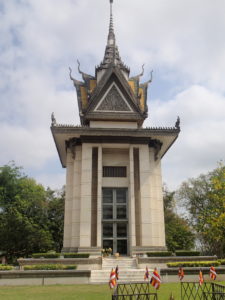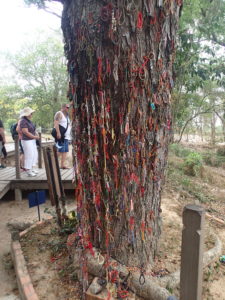 “Listen – the birds are singing. I’ve missed that.”
“Listen – the birds are singing. I’ve missed that.”
She’s right. All through Vietnam there has been hardly any birdsong, but now we’re in Cambodia, at Choeung Ek, the most famous of the hundreds of killing fields, there is.
Perhaps we hear them because our normally ebullient group is stunned into silence as our guide explains the process into our headsets, his tone without emotion. He was a tiny child when this happened. He is only alive today because his father saw what was coming and prepared accordingly. Even so, the family barely managed to keep their heads below the parapet until it was over.
In three years, eight months and twenty days from 17th April 1975 Pol Pot’s regime killed somewhere north of 1.5 million people. No-one was safe, least of all the children of between 10 and 15 years old who were brainwashed into carrying out the killings. The regime figured they would tire of it but couldn’t afford for them to talk. After eight months or so they joined their victims in the mass graves.
At Choeung Ek no-one survived. They were very careful. The victims arrived by truck, having been told they were being taken from prison to a new life. Shackled and blind-folded they were held in a wooden shelter and taken one at a time to the edge of the graves then hit over the back of the head. Then their throats and wrists were slit. Particularly sadistic killers would use the serrated edges of palm fronds instead of knives. All of this while music blared from speakers hanging in trees to drown out their screams. For children and babies the process was simpler – swing them by the feet and bash their brains out on a tree trunk studded with nails.
 Why kill babies too? Simply because the regime believed they were born with their parents’ beliefs. And the regime wanted to restock Cambodia with only the genes of 40,000 carefully chosen party members. Everyone else would die. The population of the country at the time was around 7.5 million.
Why kill babies too? Simply because the regime believed they were born with their parents’ beliefs. And the regime wanted to restock Cambodia with only the genes of 40,000 carefully chosen party members. Everyone else would die. The population of the country at the time was around 7.5 million.
Had I been born in Cambodia I would have been one of the first to go. I wear glasses, you see. And glasses were a sign of wealth and education. Education was a dangerous commodity. Even 20,000 Cambodians studying at universities abroad were lured back to the country to be part of a brave new world then imprisoned the moment their planes touched the ground. Imprisoned and killed – the same fate as any foreigner who had the mischance to be in the country at the time.
The killing field at Choeung Ek pulls no punches. The memorial at the centre contains shelf after shelf of skulls, many gazing out through the windows over the lumpy ground. Enough graves were excavated to demonstrate the scale of the atrocity and the rest left in peace. But even so as you walk around you spot the odd bone near the path or under a tree. Some of the graves have been fenced in and to these fences are fixed hundreds of friendship bracelets. They also adorn the tree where the children were killed, as far up the trunk as a human arm can reach.
The idea is to tell people, make sure the world knows so that nothing like this can happen again. But in Cambodia children are no longer taught about it in school. Perhaps because some of those associated with old regime have returned to positions of power. What seems inconceivable to us is not to a country which is fundamentally Buddhist – you do not seek revenge, you forgive. Because punishment will be dealt with after this life and is not the preserve of mortals.
While I applaud this approach it worries me that it leaves the country vulnerable. The real safety valve is probably that Cambodia is looking to build its future in large part on tourism so needs to remain an attractive destination. Which recent history aside it most definitely is.
